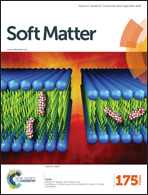Synthetic hydrogel mimics of the nuclear pore complex display selectivity dependent on FG-repeat concentration and electrostatics†
Abstract
Synthetic hydrogels were utilized to explore influence of both charge and phenylalanine–glycine (FG) repeat concentration on translocation of select proteins. Hydrogels studied represent a biomimetic platform of the nuclear pore complex (NPC) found in eukaryotic cells. Polyacrylamide/phenylalanine–serine–phenylalanine–glycine (FSFG) peptide copolymers have previously demonstrated similar selectivity to native NPCs. Entry of a nuclear transport receptor (Impβ) into hydrogels was monitored with fluorescence microscopy and observed to be greater within gels that contained larger concentrations of FG peptide. Low-resolution structural studies of gels demonstrated changes in morphology and porous network dimensions as FG-repeat concentration was varied. Copolymerization of charged acrylates within the polyacrylamide/FSFG matrix was performed to produce charged hydrogels. Enhanced entry of Impβ, which is negatively charged, was observed in positively charged hydrogels, whereas entry was greatly diminished in negatively charged gels. Synthetic NPC mimics provide a useful testbed for further investigation of nucleocytoplasmic transport and may illuminate new routes for biomimetic separations.


 Please wait while we load your content...
Please wait while we load your content...